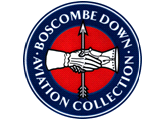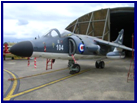

|
The first version of the Sea Harrier to enter service was designated the FRS.1 for Fighter, Reconnaissance, Strike, and the first unit to operate the type was 700A Naval Air Squadron (NAS) which formed in June 1979. The major shortcoming of the Sea Harrier FRS.1 learned during operations particularly Operation CORPORATE (the campaign to liberate the Falklands) was its inability to fight ‘beyond visual range’ or in cloud. Work began to improve the aircraft and it was originally designated the FRS.2, but removal of the strike role after the end of the cold war led to it being re-designated the FA.2 (Fighter Attack). The last Sea Harriers bowed out of service when 801 NAS decommissioned in March 2006 being replaced in the short term by Harrier GR7s and 9s of the Joint Force Harrier.
XZ 457’s first Flight was in December 1979 with Test Pilot John Farley at the controls. The aircraft was delivered to 700A NAS Fleet Air Arm Yeovilton in January 1980, wearing code 104. It was then recoded 14 when 700A NAS became 899 NAS.
From April to June 1982 during the Falklands War she was embarked on HMS Hermes. On 21st May following an attack on HMS Ardent, Lieutenant Clive (Spag) Morrell shot down one A-4Q Skyhawk A-307 with a Sidewinder and damaged another with 30mm cannon fire. The second aircraft was subsequently confirmed as a “victory” after the conflict when it was confirmed that the pilot had ejected with undercarriage failure whilst trying to land at Port Stanley airfield. On May 24th, Lieutenant-Commander Andy Auld shot down two Grupo 6 Daggers with Sidewinders over Pebble Island.
|

|
Sea Harrier XZ457 |



|
Boscombe Down Aviation Collection—Old Sarum Airfield |
|
Restoring the past for the future |